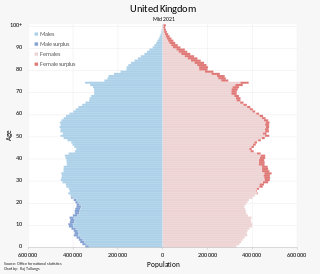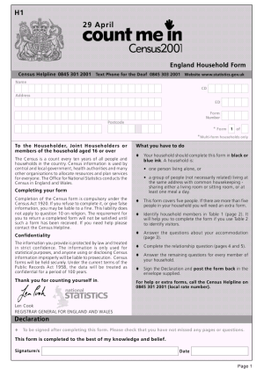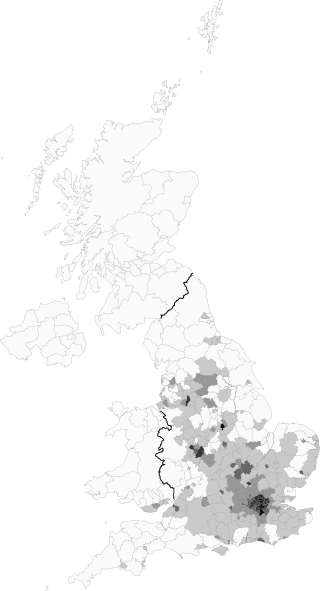Related Research Articles

The population of the United Kingdom was estimated at 67,596,281 in 2022. It is the 21st most populated country in the world and has a population density of 279 people per square kilometre, with England having significantly greater density than Wales, Scotland, and Northern Ireland. Almost a third of the population lives in south east England, which is predominantly urban and suburban, with 8,866,180 people in the capital city, London, whose population density was 5,640 inhabitants per square kilometre (14,600/sq mi) in 2022.

Demographics of Wales include population, place of birth, age, ethnicity, religion, and number of marriages in Wales.

The demography of England has since 1801 been measured by the decennial national census, and is marked by centuries of population growth and urbanization. Due to the lack of authoritative contemporary sources, estimates of the population of England for dates prior to the first census in 1801 vary considerably. The population of England at the 2021 census was about 56,489,800.
The Office for National Statistics is the executive office of the UK Statistics Authority, a non-ministerial department which reports directly to the UK Parliament.

Coincident full censuses have taken place in the different jurisdictions of the United Kingdom every ten years since 1801, with the exceptions of 1941, Ireland in 1921/Northern Ireland in 1931, and Scotland in 2021. In addition to providing detailed information about national demographics, the results of the census play an important part in the calculation of resource allocation to regional and local service providers by the UK government.

The demography of Scotland includes all aspects of population, past and present, in the area that is now Scotland. Scotland had a population of 5,463,300 in 2019. The population growth rate in 2011 was estimated as 0.6% per annum according to the 2011 GROS Annual Review.

The United Kingdom Census of 1841 recorded the occupants of every United Kingdom household on the night of Sunday 6 June 1841. The enactment of the Population Act 1840 meant a new procedure was adopted for taking the 1841 census. It was described as the "first modern census" as it was the first to record information about every member of the household, and administered as a single event, under central control, rather than being devolved to a local level. It formed the model for all subsequent UK censuses, although each went on to refine and expand the questions asked of householders.

Mixed is an ethnic group category that was first introduced by the United Kingdom's Office for National Statistics for the 2001 Census. Colloquially, it refers to British citizens or residents whose parents are of two or more races or ethnic backgrounds. The Mixed or Multiple ethnic group numbered just under 1.8 million in the 2021 United Kingdom census or 2.7% of the total UK population.

The term Other White, or White Other, is a classification of ethnicity in the United Kingdom, used in documents such as the 2021 United Kingdom Census, to describe people who identify as white persons who are not of the English, Welsh, Scottish, Roma, Irish or Irish Traveller ethnic groupings. In Scotland, the term Other White is also used to refer collectively to those not of Scottish or Other British ethnicity, in which case it also includes those of a Gypsy, Roma, Irish or Irish Traveller background.

The National Registration Act 1939 was an Act of Parliament in the United Kingdom. The initial National Registration Bill was introduced to Parliament as an emergency measure at the start of the Second World War.

Since 1922, the United Kingdom has been made up of four countries: England, Scotland, Wales and Northern Ireland. The UK Prime Minister's website has used the phrase "countries within a country" to describe the United Kingdom.

The 2021 United Kingdom census is the 23rd official census of the United Kingdom. Beginning in 1801, they have been recorded every 10 years. The 2021 censuses of England, Wales, and Northern Ireland took place on 21 March 2021, and the census of Scotland took place 364 days later on 20 March 2022. The censuses were administered by the Office for National Statistics (ONS) in England and Wales, by the Northern Ireland Statistics and Research Agency (NISRA) in Northern Ireland, and by the National Records of Scotland in Scotland. These were the first British censuses for which most of the data was gathered online. Two of them went ahead despite the COVID-19 pandemic, in part because the information obtained would assist government and public understanding of the pandemic's impact. The census-taking in Scotland was postponed, and took place in 2022 because of the pandemic.

Leicester, England is an ethnically and culturally diverse city. It is the thirteenth most populous city in the United Kingdom.

Luton, Bedfordshire, England is an ethnically and culturally diverse town of 203,201 people. It's primarily urban, with a population density of 4,696/km2 (12,160/sq mi). Luton has seen several waves of immigration. In the early part of the 20th century, there was internal migration of Irish and Scottish people to the town. These were followed by Afro-Caribbean and Asian immigrants. More recently immigrants from other European Union countries have made Luton their home. As a result of this Luton has a diverse ethnic mix, with a significant population of Asian descent, mainly Pakistani 29,353 (14.4%) and Bangladeshi 13,606 (6.7%).

Leeds, England is the third most populous city in the United Kingdom.

Bristol, England is the tenth most populous city in the United Kingdom.
The United Kingdom Census 1951 was a census of the United Kingdom of Great Britain and Northern Ireland carried out on 8 April 1951. It was the first to ask about household amenities and the largest so far attempted in the country.
MixedWhite and Black Caribbean is an ethnic group category that was first introduced by the United Kingdom's Office for National Statistics for the 2001 Census. Colloquially it refers to British citizens or residents whose parents are of a White ethnic background and Black Caribbean ethnic background. This classification is only used in England and Wales, as Scotland and Northern Ireland do not have sub categories for their mixed group options.
MixedWhite and Asian is an ethnic group category that was first introduced by the United Kingdom's Office for National Statistics for the 2001 Census. Colloquially it refers to British citizens or residents whose parents are of a White (unspecified) ethnic background and Asian (unspecified) ethnic background. This classification is only used in England and Wales, as Scotland and Northern Ireland do not have sub categories for their mixed group options.
References
- ↑ "Story of the Census". www.ons.gov.uk. Retrieved 14 August 2024.
- ↑ General Register Office: 1911 Census Schedules. The National Archives. Retrieved 6 July 2017.
- ↑ Team, National Records of Scotland Web (31 May 2013). "National Records of Scotland". National Records of Scotland. Retrieved 16 October 2024.
- 1 2 "1931 Census Records and the fire of 1942". 1901Census.com.
- ↑ "The 1931 Census". www.1911census.org.uk.
- ↑ "Story of the Census". www.ons.gov.uk.
- ↑ http://webarchive.nationalarchives.gov.uk/+/http://yourarchives.nationalarchives.gov.uk/index.php?title=1931_Census 1931 Census.] Your Archives, archived at The National Archives. Retrieved 6 July 2017.
- ↑ "The 1931 Census". www.1911census.org.uk. Retrieved 16 October 2024.
- ↑ "'Wartime Domesday' book showing life in 1939 is being made publicly available". The Independent. 1 November 2015. Retrieved 16 October 2024.